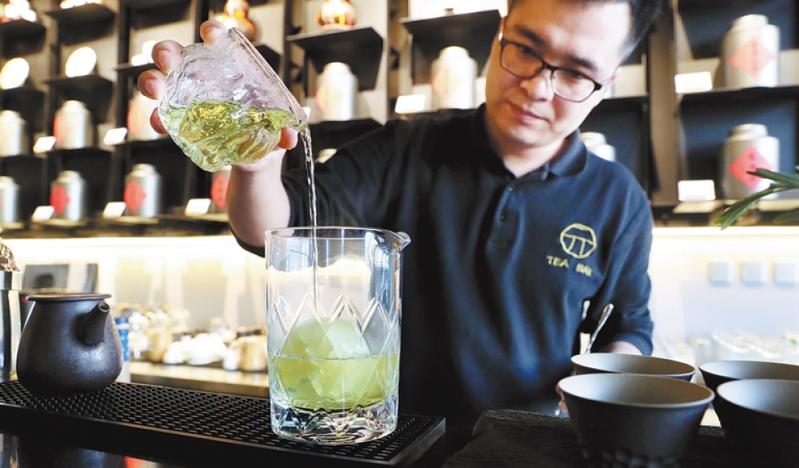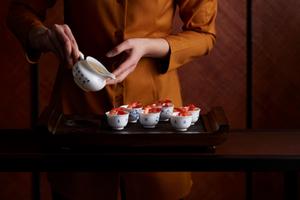 Tea-flavored cocktails are the new offerings of Yuanshe Tea Bar in Beijing. (JIANG DONG / CHINA DAILY)
Tea-flavored cocktails are the new offerings of Yuanshe Tea Bar in Beijing. (JIANG DONG / CHINA DAILY)
Using peaches from Tangshan, Hebei province, that were fresh of the branch, Chandler Jurinka, 49, co-founder of Beijing-based Slow Boat Brewery, decided to create a new craft beer.
However, one more ingredient was required to perfect the flavor of the beer, so he chose oolong tea.
After a few days of brewing, once the balance of the peach flavor and the tea flavor reaches the point where Jurinka is satisfied, the new Peach Bum Tea Ale is ready to slake the summer thirst of China's beer aficionados.
Chinese tea has become more than a simple drink, but also an ingredient with many possibilities in food and drinks. In the magic hands of chefs, brewers and bartenders, tea leaves regularly enjoy a new vitality through different forms and presentations
The combination of peach and oolong is not new for tea lovers and is already an online best-seller among young customers, particularly at this time of year with its sweet, refreshing flavor always proving to be a popular summertime tipple.
Chinese tea has become more than a simple drink, but also an ingredient with many possibilities in food and drinks. In the magic hands of chefs, brewers and bartenders, tea leaves regularly enjoy a new vitality through different forms and presentations.
It's not the first time that Jurinka has incorporated tea into his craft beer. He has also used Yunnan black tea, a variety renowned for its golden leaves and gentle sweetness, to make Tea Clipper wheat beer.
Jurinka likes to visit Maliandao in Xicheng district, Beijing's best-known marketplace for tea. He used to travel to Shanghai right after the spring tea harvest to sample the fresh Longjing tea. He plans to experiment more with tea-infused beers.
Like Jurinka, Antonio de Luca, head bartender of Tian Bar in Guangzhou, Guangdong province, likes to try different combinations of tea and liquor to create new cocktails.
One of his concoctions, named Passion, combines a soda made with jasmine tea and apple cider vinegar mixed with raspberry and sugar. It packs a complex punch on the palate with its blend of sweet, sour and aromatic flavors.
 Masters of food and drinks infuse the fragrant tea leaves into their palate-pleasing products, such as oolong-flavored cocktails and pan-fried prawns with Longjing tea. (PHOTO PROVIDED TO CHINA DAILY)
Masters of food and drinks infuse the fragrant tea leaves into their palate-pleasing products, such as oolong-flavored cocktails and pan-fried prawns with Longjing tea. (PHOTO PROVIDED TO CHINA DAILY)
Arriving in Beijing in 2018, de Luca started to drink Chinese tea, and Pu'er tea has become his favorite. He says Pu'er and whisky is a good combination for cocktails as they both have strong flavors.
"Actually tea is one of the first ingredients I always try to use when I'm creating new cocktails," he says, adding that when using tea, 85 percent of the time, it's better with gin or vodka.
Yuanchanghou Teahouse, which boasts a history of more than a century, opened Yuanshe Tea Bar in Beijing last year. The time-honored brand is hoping to attract a younger clientele with a menu of creative tea-flavored cocktails.
According to Ruan Guangfeng from China Food Information Center, the benefits of tea come from its antioxidants, such as tea polyphenols, as well as boost provided by the caffeine. Additionally, it's a good method of consuming water and staying hydrated.
He cites research published by World Cancer Research Fund International in 2015, which finds that there is some evidence to suggest that "drinking tea may lower the risk of bladder cancer".
In the book Food & Health, Evidence Based Review published in 2016 by the Chinese Nutrition Society, it says "drinking tea may lower the risk of strokes, Type 2 diabetes, cardiovascular disease, ovarian cancer and stomach cancer".
Ruan says key to healthy tea drinking is to avoid extra sugar and fat, and make sure the tea meets the trace standard of agricultural pesticide use.
"With all that considered, drinking tea in the long term is a healthy dietary habit," he says.
Fu Chun Ju restaurant in Beijing was awarded a Michelin star last year in no small part thanks to the signature dishes of chef Yeung Waikit, one of which is his pan-fried prawns with Longjing tea. The tea leaves are served in a dozen teacups, and each cup contains a prawn, over which the waiters pour tea during service.
Yeung says fried Longjing tea leaves with prawns is a traditional Chinese dish, but he wanted to add a modern twist to the method of cooking it and its presentation.
"I want the diners to try this dish like they are drinking a cup of tea, so I serve it using a tea set, a novelty which interests the diners," he says.
Yeung marinates the shelled prawns overnight in cold tea so that it absorbs the tea flavor, rather than deep frying the ingredients.
Fellow single-starred Michelin chef Li Dong also uses tea in his dishes. He uses tea to marinate beef before roasting it to enrich the flavor of the meat.
He says for Chinese chefs, tea is not only a drink but also an ingredient.
"We have a long tradition of cooking with tea leaves, such as Sichuan cuisine's Zhangcha duck, which is also known as tea-smoked duck," Li says. "The key to matching the different varieties of Chinese tea with other ingredients is pair local tea with local produce."


